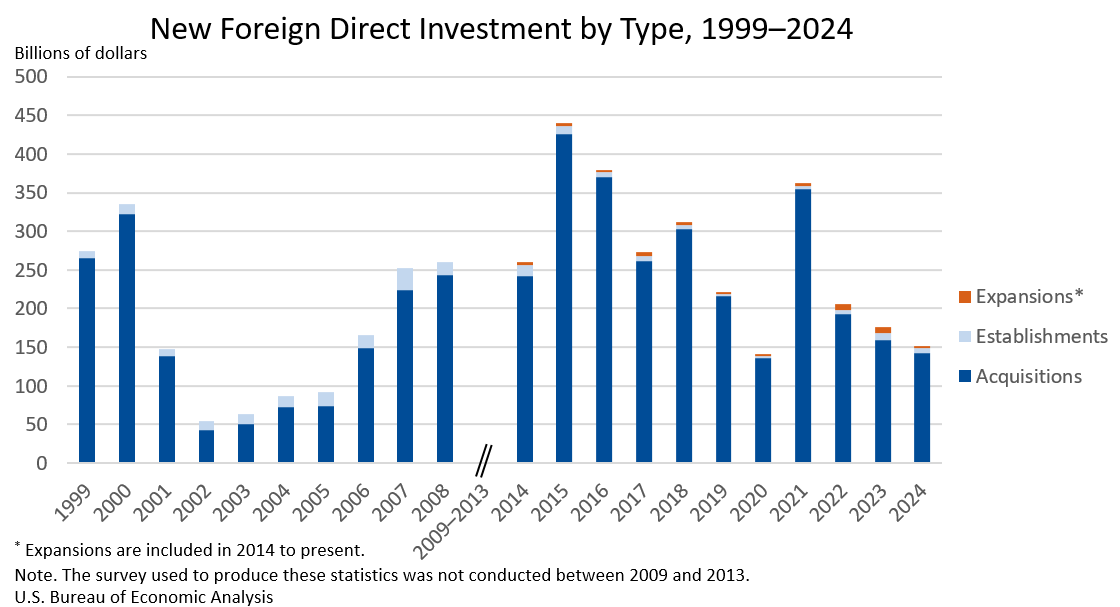Bureau of Economic Analysis
New Foreign Direct Investment in the United States, 2024
Expenditures by foreign direct investors to acquire, establish, or expand U.S. businesses totaled $151.0 billion in 2024, according to preliminary statistics released today by the U.S. Bureau of Economic Analysis. Expenditures decreased $24.9 billion, or 14.2 percent, from $176.0 billion (revised) in 2023 and were below the annual average of $277.2 billion for 2014–2023. As in previous years, acquisitions of existing U.S. businesses accounted for most of the expenditures.
Principal Federal Economic Indicators
Noteworthy
- 2025 News Release Schedule
- Innovation at BEA
- 2025 Annual Updates
- New! Services Trade Data for More Countries
- Data Tool: Trade in Value Added
- Distribution of State Personal Income
- Updated: RIMS II Regional Multipliers
- Arts and Culture
- Space Economy
- FDI Now in State BEARFACTS
- Quick Guide: Price Indexes
The Latest
Innovation @ BEA: Exploring New Data Projects
BEA is working on a variety of projects this year to bring new economic statistics your way. The goal is to give business people, policymakers and households additional tools to make informed decisions and deepen their understanding of the U.S. economy.
2015 Trade Gap is $531.5 Billion
The U.S. international trade deficit increased in 2015 according to the U.S. Bureau of Economic Analysis and the U.S. Census Bureau. The deficit increased from $508.3 billion in 2014 to $531.5 billion in 2015, as exports decreased more than imports. As a percentage of U.S. gross domestic product, the goods and services deficit was 3.0 percent in 2015, up from 2.9 percent in 2014. The goods deficit increased from $741.5 billion in 2014 to $758…
December 2015 Trade Gap is $43.4 Billion
The U.S. monthly international trade deficit increased in December 2015 according to the U.S. Bureau of Economic Analysis and the U.S. Census Bureau. The deficit increased from $42.2 billion in November (revised) to $43.4 billion in December, as exports decreased and imports increased. The previously published November deficit was $42.4 billion. The goods deficit increased $1.3 billion from November to $62.5 billion in December. The services…
U.S. International Trade in Goods and Services, December 2015
U.S. Census Bureau U.S. Bureau of Economic Analysis NEWS U.S. Department of Commerce * Washington, DC 20230 U.S. INTERNATIONAL TRADE IN GOODS AND SERVICES December 2015 The U.S. Census Bureau and the U.S.
Real Disposable Income Rises in December
Personal income increased 0.3 percent in December, the same increase as in November. Wages and salaries, the largest component of personal income, increased 0.2 percent in December after increasing 0.5 percent in November.
Personal Income and Outlays, December 2015
Personal income increased $42.5 billion, or 0.3 percent, and disposable personal income (DPI) increased $37.8 billion, or 0.3 percent, in December, according to the Bureau of Economic Analysis. Personal consumption expenditures (PCE) decreased $0.7 billion, or less than 0.1 percent.
GDP Increases in Fourth Quarter
Real gross domestic product (GDP) increased 0.7 percent in the fourth quarter of 2015, according to the “advance” estimate released by the Bureau of Economic Analysis. In the third quarter, real GDP increased 2.0 percent.
GDP highlights
Gross Domestic Product, 4th quarter and annual 2015 (advance estimate)
Real gross domestic product -- the value of the goods and services produced by the nation’s economy less the value of the goods and services used up in production, adjusted for price changes -- increased at an annual rate of 0.7 percent in the fourth quarter of 2015, according to the "advance" estimate released by the Bureau of Economic Analysis.
Industry in Focus: How Health Care and Social Assistance Fared in Third Quarter
Health care is an industry that many of us experience firsthand, whether receiving treatment for an illness or injury or simply getting an annual check-up. In the third quarter of 2015, health care and social assistance was the second-leading contributor to the 2 percent increase in the U.S. economy’s growth, providing 0.38 percentage point to real GDP.




